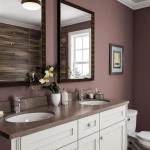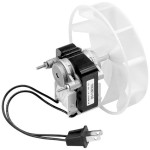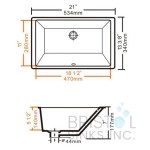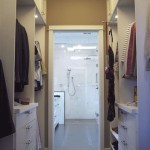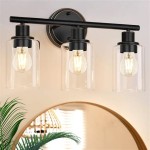Bathroom Exhaust Fan With Light And Night Light: A Comprehensive Overview
Bathroom exhaust fans are essential components of a well-ventilated and comfortable bathroom environment. They serve to remove excess moisture, odors, and potential pollutants, contributing to improved air quality and preventing mold and mildew growth. While basic exhaust fans fulfill this primary function, models incorporating a light and night light offer enhanced convenience and functionality. This article provides a comprehensive overview of bathroom exhaust fans featuring integrated lighting and night light capabilities, exploring their benefits, features, installation considerations, and maintenance requirements.
The integration of a light and night light into a bathroom exhaust fan consolidates multiple functions into a single unit, thereby streamlining installation and reducing the number of separate fixtures required in the bathroom. This combination can be particularly beneficial in smaller bathrooms where space is limited. The primary light component provides general illumination, while the night light offers a subtle, low-level light source for nighttime navigation, enhancing safety and convenience.
Benefits of Combined Functionality
The integration of exhaust, illumination, and night light functionalities into a single bathroom fixture provides several distinct advantages. Primarily, it conserves space within the bathroom. Instead of requiring separate installations for each function, a single unit combines all three, minimizing clutter and simplifying the overall bathroom design. This is especially advantageous in smaller bathrooms or powder rooms where every inch of space counts.
Secondly, the combined functionality often leads to simplified wiring and installation. Instead of running separate electrical circuits for an exhaust fan, a main light, and a night light, a single connection may be sufficient for the integrated unit. This reduces the complexity of the installation process and potentially lowers installation costs, especially when retrofitting an existing bathroom.
Thirdly, integrated units often offer energy efficiency benefits. Many models utilize LED lighting for both the main light and the night light, consuming significantly less energy than traditional incandescent or halogen bulbs. The night light, in particular, is designed for continuous operation and therefore benefits greatly from the low energy consumption of LED technology.
Finally, the presence of a night light enhances safety, particularly for elderly individuals or young children who may need to use the bathroom during the night. The soft glow of the night light provides sufficient illumination to navigate the bathroom without the need to switch on the main light, which can be jarring and disruptive to sleep patterns.
Key Features and Considerations
When selecting a bathroom exhaust fan with light and night light, several key features and considerations should be taken into account. The airflow capacity, measured in cubic feet per minute (CFM), is a crucial factor. The appropriate CFM rating depends on the size of the bathroom. A general guideline is to choose a fan with a CFM rating that is at least equal to the bathroom's square footage. For example, a 50-square-foot bathroom would require a fan with a CFM of at least 50.
The sound level of the fan, measured in sones, is another important consideration. A lower sone rating indicates a quieter fan. Opting for a fan with a low sone rating, ideally below 1.0, ensures minimal noise disruption during operation. This is particularly important for master bathrooms or shared bathrooms where noise can be a concern.
The type of lighting used in the fan is also significant. LED lighting is generally preferred due to its energy efficiency, long lifespan, and instant-on capability. Some models offer adjustable light settings, allowing users to customize the brightness and color temperature of the main light. The night light typically utilizes a low-wattage LED bulb to provide a soft, ambient glow.
The fan's housing material and construction quality contribute to its durability and longevity. Look for models constructed from corrosion-resistant materials, such as galvanized steel or plastic, to withstand the humid environment of a bathroom. The fan motor should be sealed to protect it from moisture and dust.
Additional features to consider include humidity sensors, which automatically activate the fan when humidity levels rise, and timers, which allow the fan to run for a pre-determined period after the light is switched off. Some models also offer remote control functionality for convenient operation.
Compliance with safety standards and building codes is paramount. Ensure that the chosen fan is UL listed or ETL certified, indicating that it has been tested and meets safety requirements. Consult local building codes to determine any specific requirements for bathroom exhaust fan installation.
Installation and Maintenance
Proper installation is crucial for the safe and effective operation of a bathroom exhaust fan. While some homeowners may be comfortable with DIY installation, it is generally recommended to hire a qualified electrician to ensure that the wiring and venting are properly installed. Improper installation can lead to electrical hazards, inadequate ventilation, and premature fan failure.
The installation process typically involves cutting an opening in the ceiling for the fan housing, connecting the electrical wiring, and venting the exhaust air to the outside. The vent duct should be properly sealed to prevent air leakage and condensation. The fan housing should be securely mounted to ceiling joists to prevent vibration and noise.
Regular maintenance is essential to keep the exhaust fan operating efficiently and prolong its lifespan. The fan blades and housing should be cleaned periodically to remove dust and debris, which can reduce airflow and increase noise levels. The frequency of cleaning depends on the amount of dust and humidity in the bathroom. A general guideline is to clean the fan at least once every six months.
To clean the fan, first disconnect the power supply to the fan at the circuit breaker. Remove the fan cover or grille and use a vacuum cleaner or soft brush to remove dust and debris from the fan blades and housing. Clean the cover or grille with a mild detergent and water. Allow all parts to dry completely before reassembling the fan and restoring power.
Inspect the vent duct regularly to ensure that it is free of obstructions and that the seals are intact. Replace the vent duct if it becomes damaged or deteriorated. Check the fan motor for signs of wear or damage. If the motor is noisy or not functioning properly, it may need to be replaced. Many exhaust fan motors can be replaced separately without replacing the entire unit.
If the fan has a humidity sensor, clean the sensor regularly to ensure that it is functioning properly. The sensor may need to be recalibrated periodically to maintain accurate humidity readings. Refer to the manufacturer's instructions for specific cleaning and calibration procedures.
For LED lighting, the lifespan is considerably longer. However, they will eventually need to be replaced. The ease of replacing the light bulb can vary based on the model, so consider this during selection. Some models may require disassembly of the fan unit to access the bulb, while others offer a more straightforward replacement process.
By adhering to proper installation procedures and performing regular maintenance, homeowners can ensure that their bathroom exhaust fan with light and night light provides years of reliable service and contributes to a healthier and more comfortable bathroom environment.
Choosing the Right Model
Selecting the optimal bathroom exhaust fan with light and night light necessitates a thorough assessment of individual needs and bathroom specifications. Several factors warrant careful consideration to ensure the chosen model aligns with the specific requirements of the space and the user's preferences. These key considerations include bathroom size, ventilation needs, lighting preferences, noise sensitivity, budget constraints, and desired aesthetic.
Firstly, accurate measurement of the bathroom's square footage is paramount. This measurement dictates the required CFM rating of the exhaust fan. Overlooking this aspect can lead to inadequate ventilation, resulting in persistent moisture buildup and potential mold growth. Consult sizing guides available from manufacturers and retailers to determine the appropriate CFM rating for the bathroom's dimensions.
Secondly, individual lighting preferences should be taken into account. Some users may prefer bright, task-oriented lighting, while others may prioritize softer, more ambient illumination. Exhaust fans with adjustable light settings offer flexibility to customize the lighting to personal preferences and different times of the day. Consider the color temperature of the light, measured in Kelvin (K), as it affects the overall ambiance of the bathroom.
Thirdly, noise sensitivity is a crucial factor, particularly for bedrooms, master bathrooms, and powder rooms. Low-sone models provide quieter operation, minimizing noise disruption and enhancing comfort. Reading reviews and comparing sone ratings across different models can help identify the quietest options. The decibel level is also considered, as the lower value is better.
Fourthly, budget constraints play a significant role in the selection process. Bathroom exhaust fans with light and night light range in price from basic, budget-friendly models to high-end, feature-rich options. Establish a realistic budget and prioritize the most essential features within that budget. Consider the long-term cost of ownership, including energy consumption and maintenance expenses.
Fifthly, aesthetic considerations should align with the overall bathroom design. Choose a model with a design and finish that complement the existing fixtures and décor. Consider the shape and size of the fan housing, as well as the style of the light fixture. Some models offer interchangeable grilles to match different bathroom styles.
Finally, consider the warranty offered by the manufacturer. A longer warranty provides added peace of mind and protection against manufacturing defects. Read the warranty terms and conditions carefully to understand the coverage and limitations. Reputable exhaust fan manufacturers typically offer warranties ranging from one to five years.
Akicon Bathroom Exhaust Fan With Light Dimmable 3cct Led Night 80 Cfm 2 Sones Round Silver Ak1314k1 S The Home

Ef Az107wh Azi Midnight Series 100 Cfm Ceiling Mount Bathroom Exhaust Fan With Brilliant Led Panel
Akicon Bathroom Exhaust Fan With Light Dimmable 3cct Led Night 80 Cfm 2 Sones Square Black Ak1314k2 B The Home
Akicon Bathroom Exhaust Fan With Light Dimmable 3cct Led Night 80 Cfm 2 Sones Square Black Ak1314k2 B The Home

750 Broan 100 Cfm Ventilation Fan With Light And Night Round White Grille Glass Lens 5 0 Sones Granite City Electric Supply
Akicon Dc Bathroom Exhaust Fan Light 50 80 100 Cfm 15 Watt Dimmable 3cct Led With 2 Color Night Square White Ak18cl1 W The Home

Hampton Bay 160 Cfm Ceiling Mount Room Side Installation Bathroom Exhaust Fan With Led Lighting And Night Light Lds Bf3001 The Home

Akicon Bathroom Exhaust Fan With Light 90 Cfm 1 5 Sones Dimmable Led Night Ventilation For Home Square Black

Qt Series 130 Cfm Ceiling Bathroom Exhaust Fan With Led Light And Night 26715229864

Best Bathroom Fans With Light Reviews In 2024
